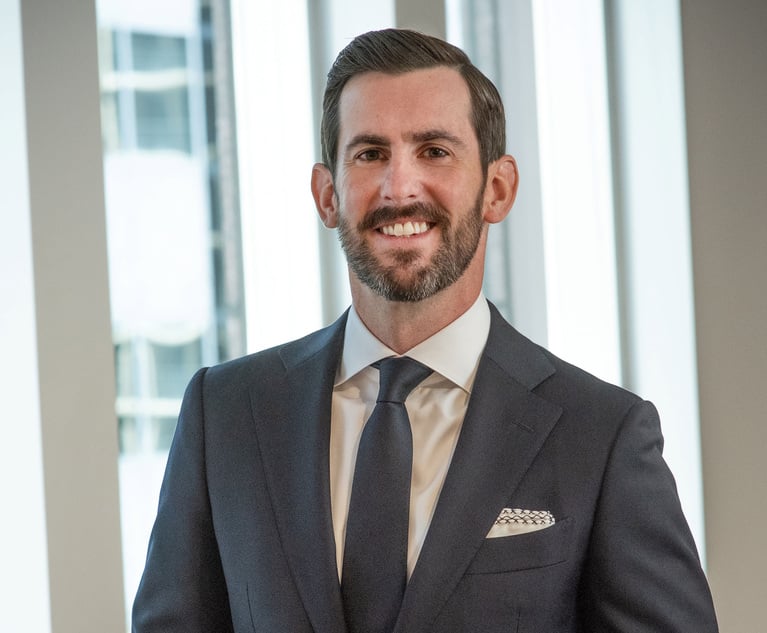With 2018 Fast Approaching, It's Time for Some Year-End Tax Planning Tips
As we approach the end of 2017, it's a great time to start thinking about year-end tax planning issues. Rather than wait until the end of December, getting a head start on planning can improve your chances of concluding matters by Dec. 31.
November 02, 2017 at 03:50 PM
6 minute read

As we approach the end of 2017, it's a great time to start thinking about year-end tax planning issues. Rather than wait until the end of December, getting a head start on planning can improve your chances of concluding matters by Dec. 31. Here are some options that we suggest you consider before the end of 2017 to enable you to start 2018 in the best wealth planning shape possible:
- Annual Exclusion Gifts. Each individual can make a cumulative annual gift tax exclusion gift of $14,000 per donee during 2017, without using any portion of his federal estate and gift tax exemption. This annual gift tax exclusion amount is set to increase for the first time since 2013 to $15,000 in 2018. The federal estate and gift tax exemption is also set to increase from $5.49 million per individual this year, to $5.6 million in 2018 (allowing a married couple to shield $11.2 million from federal estate and gift taxes). Annual exclusion gifts can be made outright, through 529 Plan benefits (education savings accounts), or in special qualifying trust structures. For those still considering such gifts, it may be worthwhile to plan for 2017 and 2018 at the same time (noting the $1,000 increase in the exclusion amount for 2018), keeping in mind that gifts for 2018 can be made effective as of Jan. 1.
- Accelerate Deductions. Prepay deductible expenses due in January (including state and local income tax estimated payments which may not be due until January).
- Loss Harvesting. Harvest tax deductible losses to offset taxable gains for 2017. However, be mindful of the 30 day wash sale rule of Internal Revenue Code Section 1091, which could disqualify a deduction of the capital loss if the same, or substantially identical, security is purchased within 30 days after selling at a loss.
- Required Minimum Distributions. For those who have reached their required beginning date or who hold inherited IRA accounts, be sure to take your required minimum distribution for 2017 from your traditional IRA or qualified plan account by Dec. 31. Note that taxpayers who are 70 ½ or older are able to transfer up to $100,000 from an IRA (other than an inherited IRA) directly to a qualifying charity (a charitable rollover) in partial or full satisfaction of their required minimum distribution for 2017. This IRA charitable rollover law, which had formerly been a temporary measure, was passed permanently as of Dec. 18, 2015, by its inclusion in the Protecting Americans from Tax Hikes (PATH) Act of 2015.
- Qualified Retirement Plan Establishment. Business owners who are considering funding a new retirement plan have the opportunity to establish a qualified retirement plan by the end of the year but defer the decision about the funding amount (and the actual contribution) until later during 2018 (contributions can generally be delayed until at least Sept. 15). The limitation for tax deductible contributions for 2017 is $54,000 per participant for defined contribution plans (or up to $60,000 when including the $6,000 catch-up contribution for a participant who has reached the age of 50). Next year this cap will be increased to $55,000 (or $61,000 when including the $6,000 catch-up).
- Roth IRA Conversion. Convert a traditional IRA to a Roth IRA to take advantage of lower brackets or absorb excess deductions. All or any portion of the converted amount can be recharacterized to a traditional IRA on or before Oct. 15, 2018.
- Basis Step-Up Planning. For individuals who have funded “grantor” trusts for their families, year-end is a good time to consider swapping back low basis assets (e.g., appreciated stock) for high basis assets (e.g., cash) to help make tax reporting after the swap cleaner (rather than switch tax identification numbers in the middle of a tax year). It's better to own the lower basis assets at death because of the opportunity for a basis step-up to fair market value under Internal Revenue Code Section 1014.
- Charitable Giving. If you are in a high income year, consider “prepaying” future charitable contributions to generate current income tax deductions. This can be accomplished simply by increasing the contributions to your favorite charities, in general, or you can defer the receipt by the charitable organizations you wish to benefit (or even defer the decision as to which ones to benefit) by contributing to a donor advised fund, a private foundation, charitable lead trust or charitable remainder trust or purchasing a charitable gift annuity. Both the charitable gift annuity and charitable remainder trust options allow you to retain an income stream for life and defer the transfer of the remaining funds to the charity until after your death.
- IRAs and HSAs. While you technically have until April 15, 2018 to fund your Individual Retirement Account and Health Savings Account for 2017, it's always a good idea to start planning for such funding at year end. Consider helping your children (to the extent that they have earned income) to fund tax favored Roth IRAs if at all possible. The maximum contributions for IRAs for both 2017 and 2018 is $5,500 ($6,500 for those who have reached the age of 50). The maximum family contribution for an HSA in 2017 is $6,750 (or $3,400 for individuals), with an extra $1,000 available for those who have reached the age of 55. For 2018, the maximum family contribution will increase to $6,900 (or $3,450 for individuals).
- Trust Income Tax Planning. While a trustee will generally have until 65 days after the end of the tax year to shift trust taxable income to a beneficiary, it's worthwhile to monitor the issue at year end to get a jump start on evaluating the issue. This is becoming a more consequential issue with the Medicare tax imposed at 3.8 percent and the extra 5 percent tax which is imposed on dividends and capital gains at the higher brackets (which are reached pretty quickly for a trust).
- Estate Plan Review. Although it's not necessarily year-end sensitive, the end of the year is a great time to review your estate plan to see if changes might be in order (whether because of changes in the tax law, your wealth, your chosen fiduciaries, or objects of your bounty). If you don't review it at year-end, you might never review it before it's too late, since you may not have any advance notice of the actual deadline.
Rebecca Rosenberger Smolen and Amy Neifeld Shkedy are members and co-founders of Bala Law Group. They focus their practices on tax and estate planning.
This content has been archived. It is available through our partners, LexisNexis® and Bloomberg Law.
To view this content, please continue to their sites.
Not a Lexis Subscriber?
Subscribe Now
Not a Bloomberg Law Subscriber?
Subscribe Now
NOT FOR REPRINT
© 2025 ALM Global, LLC, All Rights Reserved. Request academic re-use from www.copyright.com. All other uses, submit a request to [email protected]. For more information visit Asset & Logo Licensing.
You Might Like
View All
With New Civil Jury Selection Rule, Litigants Should Carefully Weigh Waiver Risks
6 minute read


Government, May I Fix My GST Mistake? Regulations Offer Guidance on Generation-Skipping Tax Exemption Allocation Relief
9 minute readTrending Stories
Who Got The Work
J. Brugh Lower of Gibbons has entered an appearance for industrial equipment supplier Devco Corporation in a pending trademark infringement lawsuit. The suit, accusing the defendant of selling knock-off Graco products, was filed Dec. 18 in New Jersey District Court by Rivkin Radler on behalf of Graco Inc. and Graco Minnesota. The case, assigned to U.S. District Judge Zahid N. Quraishi, is 3:24-cv-11294, Graco Inc. et al v. Devco Corporation.
Who Got The Work
Rebecca Maller-Stein and Kent A. Yalowitz of Arnold & Porter Kaye Scholer have entered their appearances for Hanaco Venture Capital and its executives, Lior Prosor and David Frankel, in a pending securities lawsuit. The action, filed on Dec. 24 in New York Southern District Court by Zell, Aron & Co. on behalf of Goldeneye Advisors, accuses the defendants of negligently and fraudulently managing the plaintiff's $1 million investment. The case, assigned to U.S. District Judge Vernon S. Broderick, is 1:24-cv-09918, Goldeneye Advisors, LLC v. Hanaco Venture Capital, Ltd. et al.
Who Got The Work
Attorneys from A&O Shearman has stepped in as defense counsel for Toronto-Dominion Bank and other defendants in a pending securities class action. The suit, filed Dec. 11 in New York Southern District Court by Bleichmar Fonti & Auld, accuses the defendants of concealing the bank's 'pervasive' deficiencies in regards to its compliance with the Bank Secrecy Act and the quality of its anti-money laundering controls. The case, assigned to U.S. District Judge Arun Subramanian, is 1:24-cv-09445, Gonzalez v. The Toronto-Dominion Bank et al.
Who Got The Work
Crown Castle International, a Pennsylvania company providing shared communications infrastructure, has turned to Luke D. Wolf of Gordon Rees Scully Mansukhani to fend off a pending breach-of-contract lawsuit. The court action, filed Nov. 25 in Michigan Eastern District Court by Hooper Hathaway PC on behalf of The Town Residences LLC, accuses Crown Castle of failing to transfer approximately $30,000 in utility payments from T-Mobile in breach of a roof-top lease and assignment agreement. The case, assigned to U.S. District Judge Susan K. Declercq, is 2:24-cv-13131, The Town Residences LLC v. T-Mobile US, Inc. et al.
Who Got The Work
Wilfred P. Coronato and Daniel M. Schwartz of McCarter & English have stepped in as defense counsel to Electrolux Home Products Inc. in a pending product liability lawsuit. The court action, filed Nov. 26 in New York Eastern District Court by Poulos Lopiccolo PC and Nagel Rice LLP on behalf of David Stern, alleges that the defendant's refrigerators’ drawers and shelving repeatedly break and fall apart within months after purchase. The case, assigned to U.S. District Judge Joan M. Azrack, is 2:24-cv-08204, Stern v. Electrolux Home Products, Inc.
Featured Firms
Law Offices of Gary Martin Hays & Associates, P.C.
(470) 294-1674
Law Offices of Mark E. Salomone
(857) 444-6468
Smith & Hassler
(713) 739-1250





